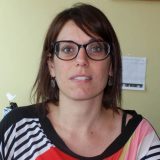Cristina Coccia
Profesora Asociada de la Facultad de Ciencias e Investigadora del Centro Bahía Lomas.
 Universidad Santo Tomás
Universidad Santo Tomás
Profesora Asociada de la Facultad de Ciencias e Investigadora del Centro Bahía Lomas.

Licenciada en Ciencia Naturales en la Universidad de Roma (Italia) y Doctora en Recursos Naturales y Medio Ambiente por la Universidad de Sevilla (España). Investigadora de la Facultad de Ciencia de la Universidad de Roma Tre e Investigadora del Centro Bahía Lomas.
Su interés de investigación se relaciona con la ecología y biodiversidad de humedales y el cambio global (incluyendo especies invasiva, cambio climático y restauración ecológica).
Actualmente es investigadora de un proyecto que examina la biodiversidad de hábitat acuáticos temporales y su respuesta a factores de cambio (e.j. contaminantes, especies invasivas etc) (Proyecto PNNR NBFC).
Su interés de investigación se relaciona con la ecología y biodiversidad de humedales y el cambio global (incluyendo especies invasiva, cambio climático y restauración ecológica). Actualmente es investigadora principal de un proyecto que examina la respuesta de invertebrados acuáticos y terrestres a perturbaciones naturales y antrópicas en humedales costero Mediterráneo (Chile y España), mediante el uso de la estructura de talla (Proyecto Fondecyt 11180668).
2021-2025. Project title: WATERZOO: Plant dispersal across Europe by WATERbird endoZOOchory: how effective are waterbirds at establishing plant populations and connecting those in different habitats? Funding entity: Ministerio de Ciencia y Innovación (Spain). Degree of contribution: Collaborator. Entity where the project take place: Doñana Biological Station (CSIC)-Spain.
2021-2023. Project title: Aves acuáticas como vectores de plásticos y nutrientes entre vertederos y humedales andaluces: GuanoPlastic. Funding entity: Junta de Andalucia (Spain). Degree of contribution: Collaborator. Entity where the project take place: Doñana Biological Station (CSIC)-Spain.
2018 –2021. Project title: “Size spectra of coastland wetland invertebrate communities in Chile: the role of disturbance”. Funding entity: Conicyt-Fondecyt Iniciacíon. Degree of contribution: Principal Investigator. Entity where the project take place: CAPES- Pontificia Universidad Católica de Chile, Santiago- Chile.
2015 –2018. Project title: “Latitudinal variation on species diversity and trophic organization of Chilean salt marsh macroinvertebrates: understanding the role of habitat characteristics and complexity”. Funding entity: Conicyt-Fondecyt postdoc program. Degree of contribution: Principal Investigator. Entity where the project take place: CAPES- Pontificia Universidad Católica de Chile, Santiago- Chile.
2016 – 2018. Project title: “Caracterizacíon ecologica del humedal de Carampangue en relacíon con las veraciones de sú regimen hidrico”. Funding entity: Empresa Arauco. P.I.: José Miguel Fariña & Carlos Ramirez. Degree of contribution: Collaborator. Entity where the project take place: CAPES- Pontificia Universidad Católica de Chile, Santiago- Chile.
2014 – 2018. Project title: “Geographical variation on the ecological idiosyncrasy of Chilean coastal saltmarshes: an experimental perspective”. Funding entity: Conicyt-Fondecyt. P.I.: José Miguel Fariña. Degree of contribution: Collaborator. Entity where the project take place: CAPES- Pontificia Universidad Católica de Chile, Santiago- Chile.
Ecological Indicators, 143, 109356.
Water, 14(21), 3449.
Estuarine, Coastal and Shelf Science, 107884.
Austral journal of veterinary sciences, 54(2), 65-75.
Journal of Applied Ecology.
Aquatic Invasions 15, 318-334.
Zootaxa 4550, 146-150
Ecology and Evolution 9, 2575-2587.
Hydrobiologia 827, 309–324.
Journal of Zoology 46, 225-235.
Functional Ecology 31: 1957-1968.